
|
||
|
Issue 60 |
|
16 December 2010 |
|
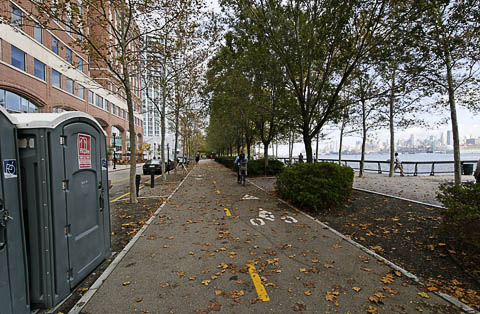 New bike path in Hoboken, New Jersey ©2010 J.Crawford AnnouncementsGaslight VillageDiscussions regarding the Gaslight Village project are ongoing. We are pleased to find a considerable level of support for the idea in fairly high places. There's nothing concrete to report yet, but we are cautiously optimistic.VideoI have recently bought a new video camera and a computer hefty enough to do the editing. I'm not sure what my subjects will be, but carfree cities will certainly figure among them. The advances in video technology are remarkable, and the production of film-grade video is now within reach of many people.The BooksCarfree Cities and Carfree Design Manual are widely available in Europe and North America.World Carfree NetworkCarfree.com actively supports World Carfree Network (WCN). The main news from the network follows.Towards Carfree Cities X to Be Hosted in GuadalajaraGuadalajara, Mexico, will host TCFC X from 5 to 9 September 2011. The call for program proposals should be released soon.World Carfree NewsWorld Carfree News is now available in Czech, English, French, German, Portuguese, and Spanish. Italian has just been added. It's a great way to keep abreast of important developments in the carfree cities network.
|
Revolting Quote of the Decade"I can't support bike lanes. How many people are riding outside today? We don't live in Florida. We don't have 12 months a year to ride on our bikes. And what I compare bike lanes to is swimming with the sharks, sooner or later you are going to get bitten. And every year we have dozens of people that get hit by cars or trucks. Well, no wonder! Roads are built for buses cars and trucks, not for people on bikes. My heart bleeds for them when someone gets killed, but it is their own fault at the end of the day."
Rob Ford
Newly-elected mayor of Toronto Speaking to City Council in 2007 Source: World Carfree News #80
News BitsGreen Party Senate Candidate Killed by CadillacNatasha Pettigrew, the Maryland Green Party candidate for U.S. Senate, died two days after she was hit by a Cadillac Escalade while cycling. She was training for a triathlon an hour before sunrise. Maryland Green Party co-chairman Brian Bittner said of Pettigrew that had "incredible potential as a future leader for this party and this state" and that the Green Party had "never experienced a loss like this."State police said the driver thought she had hit an animal and only realized what had happened when she arrived home and found Pettigrew's bicycle under her car. Pettigrew suffered severe injuries. She was wearing reflective clothing. She had long complained about the lack of bike lanes. Grist magazine said: Driving is not only unhealthy in the long run, through carbon pollution and particulate pollution. It's also incredibly dangerous. Car wrecks killed 26,791 drivers and passengers, 4,414 pedestrians, and 718 cyclists in 2008, according to the National Highway Traffic Safety Administration. If terrorists inflicted that kind of violence on the U.S., we'd do something about it.
"Maryland Green Party Senate candidate killed by SUV while cycling" Free-Fire Zone?"Is a £200 fine and three points on your licence an appropriate punishment for killing a cyclist on the road?" asked the Guardian following a court decision in which Joao Lopes was allowed to plead guilty to driving a large truck without eyeglasses. He ran over and killed Eilidh Cairns, who was cycling to work.Nothing much happened to the driver, and nothing at all happened to the company whose truck it was. For lack of witnesses, Lopes could not be prosecuted for dangerous driving, apparently a common problem under British law. Amy Aeron-Thomas, executive director of road safety charity RoadPeace, said: Killing someone on the road needs to be more costly. The freight industry will invest in safety if it's protecting their employees or their vehicles. The problem with cyclists is that their deaths aren't costly.Absent stiff penalties, a company has little incentive to act to prevent future deaths. During the investigation into Cairns's death, police didn't test Lopes's eyesight despite his account of what happened--"I didn't see her." Only months later did they finally test his eyesight and find it substandard. At the inquest into Cairns's death the coroner said such deaths were "not an uncommon occurrence in London" and that "cycling groups and the police will be grappling with this for a very long time." She made no recommendations about how to save cyclists' lives. Cairns's family is challenging the accidental-death ruling.
"Does the law treat killing a cyclist seriously enough? Heavy Truck Ban Considered in UK CitiesThe statistic is shocking: heavy good vehicles (HGV) make only 4% of road trips but were involved in 43% of London's cycling deaths. Researchers analyzed police road casualty data from 1992 to 2006. In London during that period there were 242 deaths; HGVs were involved in 103 of them.London mayor Boris Johnson now plans to ban big trucks from central London. The latest call from the experts came on the same day that a truck driver was found guilty of a dangerous-driving death. He flattened a cyclist while chatting on his mobile phone. He was also legally drunk. He received a seven-year sentence and was banned from driving for life. "Trucks with high cabs are designed for motorway driving and should not be allowed inside city limits," said Dr Andrei Morgan, who led the research. "Cyclists can do as much as they like in terms of making themselves visible: they can wear neon and cover themselves in lights, but truck drivers can't see them because they are too high up, the angles are wrong. Advanced stop lines are helpful but they don't solve the issue." The research found that 53% of cyclists killed by trucks were crushed by trucks turning left across them (right, in countries that drive on the right). European studies reached similar conclusions. An earlier British study of cycling fatalities between 1985 and 1992 reached the same conclusions. Morgan believes that banning trucks that weigh more than 3.5 tonnes (about 3.85 tons) from cities would save lives. Goods would be transshipped to smaller trucks at a network of distribution centers on the edge of towns. The practice is already widespread in Germany, he said. Morgan further said, "This unnecessary death toll cannot be ignored any longer. At a time when we are seeking to encourage more people to cycle, both for health and environmental reasons, this is not good enough." Although metro-freight, as proposed in Carfree Cities, is difficult to implement in existing cities, it achieves an even larger safety improvement, since all trucks (with possible rare exceptions) are kept out of the city. It also reduces the noise burden and energy consumption. In new cities there is every reason to adopt it.
"Experts call for ban on HGVs in Britain's cities to protect cyclists Huge CicLAvia in Los AngelesSeven miles of streets were made carfree on a recent Sunday in LA. They were taken over by bikes, skateboards, and pedestrians. Not a horn to be heard, nor exhaust fumes to choke on. A crowd estimated at 100,000 turned out for the city's first CicLAvia, which challenged prevailing assumptions about transit, exercise, and public space in the world's premier auto-centric city.The LA Times marvelled: The turnout and ease with which the event went off far surpassed the expectations of organizers, who had questioned whether Los Angeles could accommodate and tolerate the idea of shutting down heavily traveled streets for no other reason than to let Angelenos on foot and pedal have the run of the place.Organizer Aaron Paley said: This was amazing--a huge success. This was about giving people of Los Angeles another way to experience their city. . . . It was about what belongs to us. The streets of L.A. belong to us. If we think to repurpose them, they are our greatest public space.CicLAvia had no organized events. A few first-aid stations and information stands and some portable toilets were established at points along the route, but it was up to those who came to use the streets as they wished. For the vast majority, that meant cycling. People of all ages and sizes turned out. There were no incidents of note. Some people saw the experience as more than just a chance to exercise. Rafael Navar said: We're alone in our cars. We pass above whole neighborhoods on freeways and never actually see them. Today, I've seen buildings I never took the time to lay eyes on before. Today gave people a chance to just slow down and it connected the neighborhoods of the city in a new way. That's important.People were surprised to find that the city felt smaller and more manageable Sunday. Many had expected the journey from East Hollywood to Boyle Heights to take far longer and be far more arduous than it actually was. Cyndi Hubach, 49, and Kevin Mulcahy, 45, noted that the 45 minutes they took to cover the route may have been shorter than what it would have taken in typical car traffic. For many, these realizations led them to wonder what life could be like in Los Angeles. Mulcahy said: Being able to ride freely and safely right through what you knew were usually really dangerous intersections, it got you thinking about what it could be like if the city created a network of dedicated bike routes. Getting from place to place would take on a whole new light.More CicLAvia days are being planned. The ultimate goal would be to make CicLAvia a weekly event. That was done three decades ago in Bogotá, Colombia, and it transformed that city.
"An estimated 100,000 turn out for L.A.'s inaugural CicLAvia event" Groningen: Car-Lite in the NetherlandsGroningen is the Netherlands' sixth largest city, located in the northeast of the nation, near the German border. The main transport mode in this university town is the bicycle. Sixteen years ago, traffic congestion led city planners to remove main roads in the center. Last year they set about creating a carfree city center. Groningen, population 170,000, has the highest level of bicycle usage in the West, with 57% of citizens traveling by bicycle. This compares with 4% the UK and probably even less in the USA.The economic benefits have been large. In 1977 a six-lane motorway intersection in the city center was replaced by greenery, pedestrianization, cycleways and bus lanes. Since then, the city has staged a remarkable recovery. Rents are high, and population loss has been reversed. Businesses once in revolt against car restrictions now clamor for more of them. The measures are seen locally not in environmental terms but economic terms. Jobs have been created and business is thriving. Shopkeepers routinely request car bans in streets that have not yet been cyclized. And it turns out, to nobody's surprise, that building for bikes is cheaper than building for cars. Through simple weight of numbers, the bicycle makes the rules, slows traffic, and affects the attitudes of drivers. Throughout the city, roads are being narrowed or closed to cars, and cycleways are being constructed. New housing is being built to which the only direct access is by cycle. Out-of-town shopping centers are banned. Cars are forced to take long detours to get to most places, but direct cycle routes are provided by a fine meshed network of paths, with easy access to the center. Bicycle-friendly measures such as separated cycle paths, advanced stop lines at traffic lights, and official sanction for cyclists to turn right at red lights are routine. City planner Gerrit van Werven said: We don't want a good system for bicycles, we want a perfect system. We want a system for bicycles that is like the German autobahns for cars. We don't ride bicycles because we are poor--people here are richer than in England. We ride them because it is fun, it is faster, it is convenient.And that about says it all.
"Groningen, the car-free city for bikes" America's Pale Imitation of GroningenPortland, Oregon, is widely regarded as America's most livable city, a pioneer in innovative green measure that also support stronger community ties.Portland enjoys the highest share of bicycle commuters (6-8%) of any large US city. It wasn't always that way. Relative success follows twenty years of effort to plan a city that works for bikes. Recently, the city council unanimously approved the 2030 Bicycle Master Plan, which calls for three times as many bikeways as today. The regional goal is for 40% of all city and suburban trips of three miles or less to be made by bike by 2040. Already, in some neighborhoods, 10-15% of people use their bikes every day. Portland is focusing on the 60% of people who say they would like to cycle but don't feel comfortable with all the cars. Portland officials think the best approach is to make biking seem less scary. The new Bicycle Master Plan will augment the city's established network of bike lanes separated from traffic by nothing more than a white stripe. The city is planning more bike boulevards optimized for bikes, rather than cars. Off-street trails are also being considered, as is physical separation from car traffic. It seems that people will go out of their way to ride on a bike boulevard. Other best-practice approaches, mostly pioneered in Europe, are also being applied. This includes bike boxes at traffic lights, colorized bike lanes, traffic signals for bikes, and general traffic calming approaches. This includes elevated crosswalks and traffic diverters, which give bicycles priority on some streets. The city of Portland has launched a social marketing effort called Smart Trips. The campaign focuses on particular parts of the city where car use is above average. It begins with the mailing of a flyer to area residents asking about their interest in biking, walking, or taking transit. Those who show interest are visited by a friendly transportation ambassador, a personal-mobility coach who can answer questions about getting around in Portland without a car. Neighborhoods served by Smart Trips have shown a 9% drop in single-occupancy vehicles. The biking push is expected to cost $600 million over twenty years. Progress is actually comparatively cheap when compared to increasing mobility by other means. Between 2001 and 2007, bike facilities cost just 1% of Portland's overall capital expenditures for transport but carried 3-7% of all trips. The new plan increases spending on bikes to 5% of the city's transport budget. Minneapolis, New York, Chicago, Seattle, and Washington are playing catch-up. A dozen other cities have joined the race.
"How Portland plans to become the first world-class bike city in America." 500 Million Empty Parking SpacesThere are at least 500 million empty parking spaces in the USA at any given moment. America's 250 million cars and trucks are big contributors to climate change, but little research had been done regarding the impact of parking spaces.Donald Shoup, author of The High Cost of Free Parking, said: I think it's a surprisingly unknown quantity. [Parking] is the single biggest land use in any city. It's kind of like dark matter in the universe, we know it's there, but we don't have any idea how much there is.Engineers at the University of California at Berkeley recently published the first full estimate of parking spaces in the USA. They found that the energy use and materials associated with creating hundreds of millions of parking spaces has a significant environmental impact. Until now, the only available measure had been the number of metered parking spaces, which number was about 100 million. It was obvious that there were a great many more spaces, but the number was unknown. The glaring gap in the data convinced the team to attempt the first ever nation-wide count of parking spaces. The new count includes street-side parking, building code requirements, parking garages, lots at big-box stores, and parking spaces at work and home. It turns out that there are probably 800 million parking spaces in the USA, or about three official parking spaces for every car on the road. (There had been a long-cited figure of eight spaces per car, but there did not seem to be a reliable source for this figure, and it was probably simply pulled out of thin air by somebody and then quoted by writers desperate for some sort of figure.) It appears that the parking infrastructure actually occupies more space than roads, which comes as no great surprise to anyone who has considered the matter. Once the parking estimate was completed, the researchers calculated the energy requirements and emissions from asphalt and other materials needed to build and maintain parking infrastructure. "We've traditionally thought about the environmental impact of parking as being limited to the heat island effect," said study author Mikhail Chester. "The amount of parking has a rather drastic impact on the energy and emission contributions from vehicles."
"The first nationwide count of parking spaces demonstrates their high environmental cost Feature Article
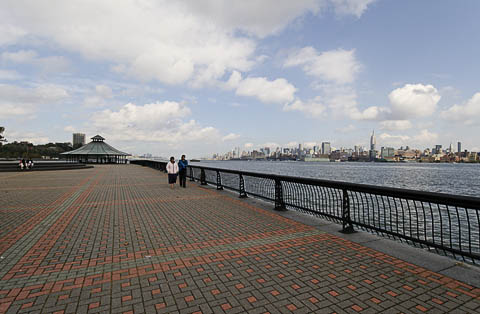 Manhattan as seen from the Hoboken waterfront A long-neglected city comes back to life, and taming the car is job #1. ©2010 J.Crawford Reinventing HobokenPerhaps Hoboken got caught up in the general Hudson County corruption that plagued that area for many decades and is now finally being cleaned up. Certainly neither it nor the adjacent towns had a good name in the post-war era. Now, however, its close proximity to Manhattan is finally turning the tide. It's closer to mid-town Manhattan than northern Manhattan is. And a new generation of politicians is determined to reinvigorate this mile-square city built on a grid of one-way streets. The Main IdeaThe new director of Transportation and Parking is Ian Sacs, who has a direct line to the mayor. They are taking an approach to improving transport in the city as a key means to make the city more livable. They recognize that major change can't happen over night, and that people have to be weaned from their cars gradually. They need a chance to see that there is life after cars.
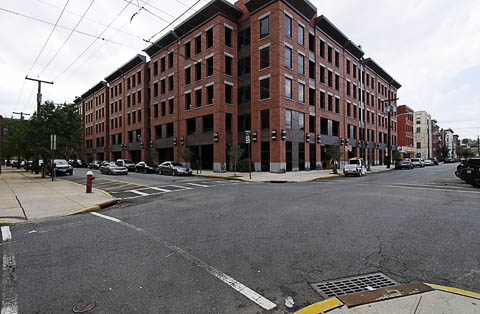 New parking garage This is the first multi-story garage I didn't immediately recognize as such. ©2010 J.Crawford In practical terms, this means focusing on parking. The city has issued 17,000 parking permits but has only 10,000 spaces, so parking is almost always a problem. They have offered a parking cash-in program that suggests, "Live car-free with the following rewards valued at over $500." What you get is discounts on car sharing, a bike training session, a 6-month Hop pass for the minibus, $20 towards new shoes, and some other small temptations. The idea is simply to get some of the cars cluttering the city off the streets. US Transportation Secretary Ray LaHood recently cited Hoboken as an example of a walkable city. Distances are short, and the city is ringed by barriers that have tended to keep it somewhat landlocked and thus still fully equipped with practically everything people need in their daily lives.
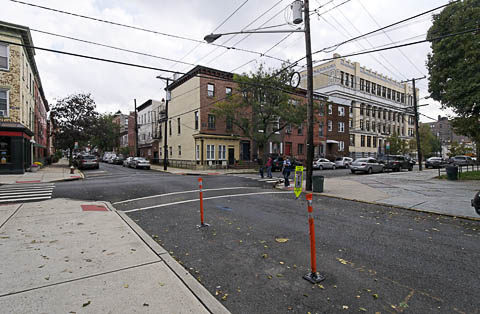 Corner that has received the "daylighting" treatment The orange posts prevent cars from parking and improve sight lines at the crossing. ©2010 J.Crawford Improved conditions for pedestrians has been a key goal. The city is now rigorously enforcing no-parking regulations at the approaches to intersections, so that pedestrians and drivers can see each other. They have also opened up some intersections by extending the no-parking zone farther away from the intersection. Pedestrian safety and rights have been an important focus. Biking has also received a great deal of attention. More and more bike lanes are being added. For decades, streets were dominated by cars, but Hoboken is carving out space for cyclists, and drivers are starting to become accustomed to seeing bikes on the street. Quite a lot of bike parking has already been established, and much more is on the way.
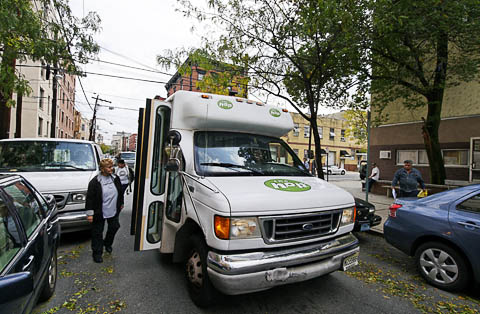 One of the Hop's minibuses ©2010 J.Crawford A three-route minibus system, the Hop, has been implemented. It runs full during rush hours and seems to see brisk use during most of the day. Its routes converge on Hoboken Terminal, the train station and also where the PATH trains to New York originate. Most residents of the city are within two blocks of a stop. The buses run their loop routes in 30 minutes or less. Buses are equipped with GPS trackers, so riders can see how soon one will be coming along. Unlimited-ride passes will soon be inaugurated, making it more convenient to take a Hop.
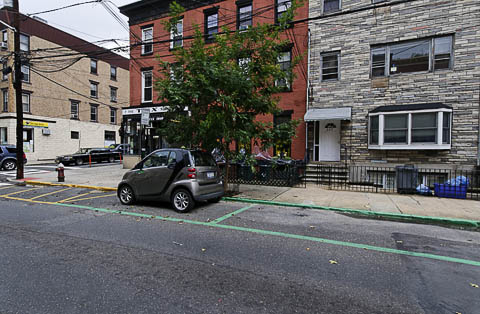 A Smart car that is part of the car-sharing fleet ©2010 J.Crawford A car-sharing initiative has been instituted. The "Corner Cars" program currently runs with a 1:17 ratio of cars to members. The car-sharing vehicles have reserved parking, which makes them attractive to use and saves people the expense and bother of owning a car in a town where there is never enough parking. Many people who owned cars did not use them very often, so car sharing is a natural for them, and the program has grown fairly quickly. Membership is free--you pay only for what you use. Hourly charges are as low as $5/hour, although about $10 is more typical. A $25 application fee buys you $75 in driving credits. In the USA, this is about as good as it gets these days. Most Americans are so used to driving everywhere they go that any change in their behavior is very hard to achieve. It's necessary to proceed rather slowly with changes and, above all, not to frighten people. So, I think we're going to see quite a few programs like the one in Hoboken. They will be the first inkling most Americans have had that there are other ways to get about.
Hot New LinksThe links below will open in a new browser window:
"Bikes versus cars: Who pays their fair share for Vancouver's roads?" "The spacing of stops and stations" at Human Transit "Life outside the box " on living carfree "Bicycle freight: thinking outside the box truck" "Bicycle facilities in Paris" at LiveStreets "'Hybrid' Streetcar Loses Its Wire" at Earth Techling "In Arabian Desert, a Sustainable City Rises" See this interesting series from The Tyee: "Why a Streetcar Is Something to Be Desired" "Cul-de-sacs: Dead Ends in More Ways Than One" "How to Get People Out of Their Cars" See their index page for the remainder of the series: "Seven Rules for Sustainable Communities" Contrasting Visions of Urban Transport: Critique of "Fixing Transit: The Case For Privatization" [PDF!] from VTPI
About Carfree TimesNext IssueThe next issue of Carfree Times is scheduled for early 2011.
Subscribe to Carfree TimesCarfree Times is published quarterly at Carfree.com. To receive e-mail notices of new issues, please visit the subscription page or send e-mail with the word "Subscribe" in the subject line. We do not share our mailing list.Write for Carfree TimesInterested in writing for Carfree Times? We welcome articles on a wide variety of subjects and offer an opportunity to publish letters to the editor and guest editorials. Drop us an e-mail.
Statement of OwnershipIn this day of corporate-influenced media, it is perhaps incumbent upon Carfree.com to declare its ownership and sources of support.Carfree.com is wholly owned by Joel Crawford, the legal name of author J.H. Crawford. Its operation is financed by J.H. Crawford, with the help of some generous donors between 2004 and 2008. It generates no revenues directly but does help support book sales. Carfree.com accepts review copies of books but makes no commitment to review them. J.H. Crawford receives no commissions from the sale of books mentioned on Carfree.com. The views expressed at Carfree.com are those of J.H. Crawford, except for articles, letters, and editorials that carry the names of other authors. The inclusion of these signed texts is at the sole discretion of J.H. Crawford, who does not necessarily agree with the views expressed. All other content, except quoted material, is written by J.H. Crawford. E-mail announcements of new issues of Carfree Times are mailed to approximately 850 subscribers. A rough estimate of first-year circulation for each new issue is 5000. All the issues ever published are still being read. Carfree.com as a whole will have served about 1.3 million pages and 128 GB of files in 2010. |
| Editor | J.H. Crawford |
| Send e-mail | |
| URL | http://www.carfree.com/
|
Back to Carfree.com
Carfree Times Home
Back to Carfree Times Issue 59
Forward to Carfree Times Issue 61
E-mail
carfree.com
Copyright ©2010 J.Crawford